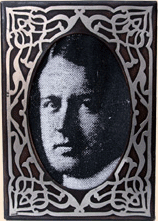|
|
 |
|
|
 |
 |
ABOUT HEINTZ |
| |
 |
Otto Heintz was born into a family of
manufacturing jewelers established in 1875
in Buffalo , NY . By about 1902 he had
purchased a small company, renamed it the
Art Crafts Shop, and began design and
manufacture of copper items with colored
enamel decoration. He was granted three
patents. By 1906 he changed the name to
Heintz Art Metal Shop, and shifted to bronze
as the base material and sterling silver as
ornamentation. The Art Crafts Shop hammered
“look” was replaced by a series of
machine-shaped bodies with sophisticated
patinas. The definitive patent for applying
sterling silver to bronze without solder was
granted August 27, 1912 .
Heintz’ line consisted of vases and bowls,
candlesticks, smoking accessories, trophies,
lamps, desk accessories, picture frames,
bookends and jewelry. From a circa 1916
trade catalog: “Heintz wares have won an
enviable reputation among buyers of art
goods, because of originality and beauty of
design, and unusual quality of
attractiveness. The articles are of bronze,
and are decorated with sterling silver
designs, permanently applied by our patented
process. Beautiful colored finishes have
been produced after much thought and
experiment...... |
 |
|
|
|
|
|
|
|
|
|
|
 |
 |
These factory finishes, referred to as
patinas, are unique and noteworthy. The
brown and verde (green) exhibit variegated
tones, while the Royal is a rich red with a
hint of iridescence. A “two-tone” finish
exhibits an aura of dark oxidation around
the overlay while the rest of the body has a
lighter ground color. Heintz also employed
plated finishes: a hand-stippled French grey
silver, Acid etched silver with black
“highlights” and Gold dore’. Heintz items
were a popular wedding gift and were sold
through “better” gift and artware stores.
New specimens continue to appear for
collectors.
Otto Heintz died suddenly on January 10,
1918. Sales manager Fred Smith and some
major craftsmen defected and began to
compete with their old employer under the
name Smith Metal Arts Co., incorporated
April 24, 1919. The Heintz Art Metal Shop
continued for another 12 years until finally
succumbing to the Great Depression on
February 11, 1930.
A good reference:
“The Heintz Connection”, Michael James, Arts &
Crafts Quarterly, Vol. VI, No. 1, Spring 1993, pp.
12-20
* Back issues of Style: 1900, Volume 11, No. 2, “The
Metal Issue” are still available. It is the best
reference on all Arts & Crafts period “brown metal”. |
 |
|
| |
|
 |
| |
|
 |
| |
Interested in other Arts & Crafts period metalwork?
Try these sites:
www.roycroftcopper.com
www.1910metal.com
www.chicagosilver.com |
| |
|
|
|
|
